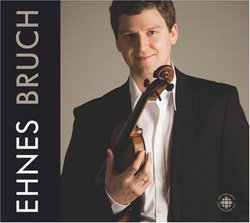| All Artists: Bruch, Dutoit, Bernardi, Montréal Symphony Orchestra, Ehnes Title: Ehnes Plays Bruch Members Wishing: 1 Total Copies: 0 Label: Cbc Original Release Date: 1/1/2008 Re-Release Date: 6/24/2008 Genre: Classical Styles: Forms & Genres, Concertos, Instruments, Strings, Symphonies Number of Discs: 2 SwapaCD Credits: 2 UPC: 059582524527 |
Search - Bruch, Dutoit, Bernardi :: Ehnes Plays Bruch
 | Bruch, Dutoit, Bernardi Ehnes Plays Bruch Genre: Classical
|
Larger Image |
CD Details |
CD ReviewsFour Bruch Violin-and-Orchestra Works, Nicely Played J Scott Morrison | Middlebury VT, USA | 07/30/2008 (4 out of 5 stars) "Max Bruch (1838-1920) comes very close to being a one-hit wonder. Everyone plays his Violin Concerto No. 1 in G Minor, Op. 26. A few play his Scottish Fantasy, Op. 46. But almost nobody plays his Second and Third Violin Concertos. One wonders why, as the latter two are really quite nice pieces. But there's no understanding what makes one work popular and another a part of the trash heap of history. For this reason, it is particularly good to have this 2CD set from the up-and-coming Canadian violinist, James Ehnes (pronounced 'Ennis'), accompanied by the Orchestre Symphonique de Montréal. One can hear that all four of these pieces are worthy of places in the violin-and-orchestra repertoire.
There are many recordings of the First Concerto. My own personal favorite is one that is no longer easily available, the one with Jaime Laredo. But one cannot ignore recordings by such luminaries as Itzhak Perlman, Kyung-Wha Chung and Maxim Vengerov. Ehnes's approach to this concerto, and indeed to all three of them, is an elegant and lyrical one. This is not necessarily what others do. The First is generally played with a bit more fire and brilliance, but to be honest Bruch's style is possibly better served by Ehnes's subtlety. The Second Concerto came ten years after the First and was premiered in 1877 by none other than Sarasate. It is unusually structured with a slow first movement, a dramatic, even operatic, second movement marked 'Recitativo', and a somewhat jaunty finale. The Scottish Fantasy was written two years later and although it is not often played in concert, it has had a pretty good history of recordings, including classic, long-treasured ones by Jascha Heifetz and Michael Rabin. It was inspired, Bruch said, by reading the novels of Sir Walter Scott. The work was occasionally listed in its early days as the Third Concerto, but at least partly because of its unusual form, really more of a musing on Scottish themes, it has come to be called simply the 'Scottish Fantasy' which is a more apt description. The Third Concerto was written for Joseph Joachim and premiered in 1891. Its form is more typical: Fast - Slow - Fast. The Allegro sounds almost as if it could have been written by Brahms with its alternation of 2- and 3-note rhythms. The adagio is notable for its lyrical theme which is not only beautiful but is one of those rare themes that sticks in memory after just one hearing. The finale makes much use of a cantering rhythm coupled with exciting double-stops from the soloist. The First and Third Concertos are conducted by the OSM's former music director, Charles Dutoit; the Second Concerto and the Scottish Fantasy by Mario Bernardi. I frankly heard little difference between the approaches of these two conductors, and the OSM sounds its usual suave self. This set is easily recommendable and all the more so because of its low price. Scott Morrison" |

 Track Listings (6) - Disc #1
Track Listings (6) - Disc #1